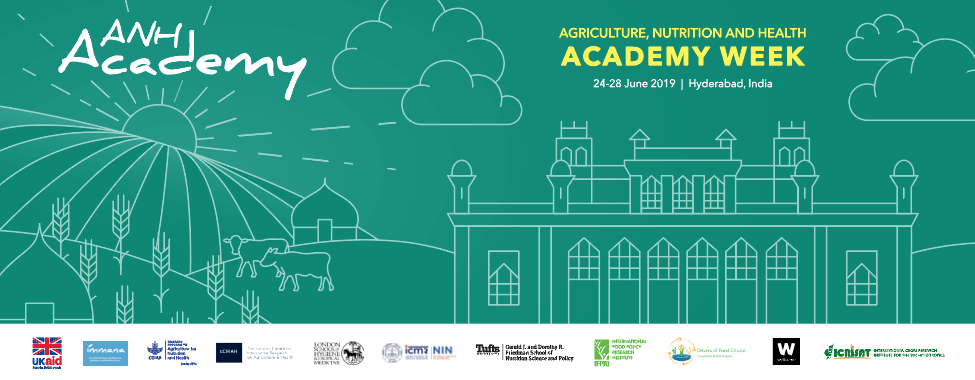
Six, 10-minute abstract-driven presentations.
Speakers and Presentations:
- Chair: Amos Laar, African Nutrition Society (ANS) and University of Ghana
-
Pepijn Schreinemachers, World Vegetable Center
Long-term behavioral impact of an integrated home garden intervention in Bangladesh
Slides/ Recording -
Suneetha Kadiyala, London School of Hygiene & Tropical Medicine (LSHTM), UK
Linkages between land, gender and diets in rural India: A mixed methods approach
Slides/ Recording -
Stella Nordhagen, Global Alliance for Improved Nutrition (GAIN)
Sustainability of community-level approaches to nutrition-sensitive agriculture: A case study from Cote d’Ivoire
Slides/ Recording -
Jef Leroy, International Food Policy Research Institute (IFPRI)
The unintended effects of interventions: A food-assisted maternal and child health and nutrition program contributes to postpartum weight retention in Guatemala
Slides -
Taddese Zerfu, African Population and Health Research Center (APHRC), Kenya
Livestock ownership, not maize production, is associated with maternal anemia in malaria endemic rural low-income settings
Slides/ Recording -
Babar Shahzad, Khyber Medical University, Pakistan
A randomised controlled trial to examine the effect of consuming flour made from biofortified wheat on the zinc status of women living in a rural community in Pakistan
Recording -
Q&A
Recording
Abstracts:
Long-term behavioral impact of an integrated home garden intervention in Bangladesh
Pepijn Schreinemachers, World Vegetable Center
Introduction: Home garden interventions – integrating training in gardening with nutrition education – have much potential to improve nutrition behavior of poor households in developing countries. Previous studies have shown that even small gardens can supply large amounts of micronutrients. Yet, evidence is lacking for their sustainability as nearly all evaluations have studied short-term effects. Therefore, the objective of this study is to quantify the impact of home gardens on vegetable production and consumption three years after a project intervention and to test whether this is different from the impact after one year.
Methods: We study a home garden program implemented in southwestern Bangladesh and funded by the United States Agency for International Development. We use three rounds of survey data: collected before the intervention, one year after the intervention, and three years after the intervention. Each wave tracked the same households in an intervention group of households included in the program and a comparable group of control households not included in the program. While the allocation of households into either group was not randomized, the same eligibility criteria were used for both groups and baseline data exhibit no evidence of selection bias. The sample has complete data over three waves for 395 intervention and 224 control households. A difference-in-difference estimator was used to quantify impact. Primary outcome variables included vegetable production, micronutrient yields, and vegetable consumption. Micronutrient yields were calculated using nutrient conversion factors. Secondary outcome variables included the adoption of improved gardening methods, women’s knowledge of food and nutrition, and a measure of women’s self-perceived level of empowerment.
Findings: Three years after the intervention, the use of improved gardening methods was significantly higher among intervention households than control households. The average quantity of home garden vegetable production was 87 kg before the intervention and this quantity increased by 29 kg in the endline (that is, one year after the intervention) and by 43 kg in the long-term endline (that is, three years after the intervention) vis-à-vis the baseline, with these changes being highly significant (p<0.01). The difference in impact between endline and long-term endline was not significant (p=0.42). It shows that the initial increase in vegetable production after the intervention was sustained three years after the intervention. The intervention significantly increased the supply of iron, zinc, folate, vitamin A, calcium, and vitamin C. There was no significant difference in impact between the endline and long-term endline, except for calcium and vitamin C, which slightly declined as a result of a shift in the composition of garden produce from leafy vegetables to more cucurbits. Furthermore, the results show that the training led to a significant increase in the quantity of vegetables consumed, the level of women’s knowledge about food and nutrition, and in their perceived level of empowerment.
Conclusions: Integrated home garden interventions, bundling training in gardening with nutrition education, lead to sustained, long-term changes in human behavior that contribute to the increased production and consumption of vegetables in poor rural households. They can therefore be an effective tool to promote dietary diversification, which addresses one of the root causes of malnutrition in low-income countries.
Linkages between land, gender and diets in rural India: A mixed methods approach
Suneetha Kadiyala, London School of Hygiene & Tropical Medicine (LSHTM)
Introduction: The evidence on linkages between land ownership and diets is mixed. Studies in Bangladesh show no significant association between land ownership and women’s dietary diversity after adjusting for confounding. Gender dynamics might explain this heterogeneity, whereby gender norms and processes may moderate or mediate the associations between land and diets. We examine the association between land and women’s diets, and whether women’s empowerment might explain this association.
Methods: The research questions posed here are:
- Is maternal dietary diversity score (out of 10 food groups) associated with size of household landholdings (In-land size)?
- Does women’s empowerment [women’s land ownership: (none, joint, sole ownership); women’s decision-making: (<2 vs ≥ 2 productive decisions); women’s group participation: (active group member vs not); and women’s leisure time: (<10.5 vs ≥ 10.5 hours of work)] mediate the relationship between ln land size and maternal dietary diversity score?
We use a mixed methods approach using data from i) a quantitative baseline cross-sectional survey of 4,736 randomly selected households with mothers of children under two years of age in 148 clusters and ii) qualitative data from 36 semi-structured interviews with pregnant women and mothers of children under two years of age and their family members, and six focus group discussions (FGD) with women members in self-help groups. The data were collected as part of the of a four-arm cluster-randomised controlled trial in Odisha, India: Upscaling Participatory Action and Videos for Agriculture and Nutrition (UPAVAN). Quantitative data were analysed using linear and logistic regression models informed by a Directed Acyclic Graph in Stata SE, while the qualitative data were transcribed and coded in Nvivo.
Findings: Household land size is positively associated with maternal dietary diversity, with and without adjustment for female-only household, caste, mother’s age, and household size (adjusted coefficient (aβ) = 0.11; P<0.001). Some domains of women’s empowerment may mediate the association between landholdings and dietary diversity. For example, women from households with more land have higher odds of participating in wider community groups (OR = 1.12; P<0.001); and group participation is also slightly positively associated with diet diversity (aβ = 0.23; P<0.001). Other domains of women’s empowerment modify the association between landholding size and dietary diversity. For example, women who jointly own household land have better diets (aβ = 0.48; P<0.001) than women who don’t own land, and the positive effect of land on dietary diversity is significantly lower when land is solely owned by women (aβ sole = 0.34; P=0.22). Consistent with this, some women in FGDs felt that either jointly or solely owning land would enable them to grow diverse foods, and decide how to invest the income. However, many women also expressed concerns about the acceptability of women owning land, due to ‘disobedience’ and disagreements that might follow, indicating that women’s land ownership may not be amenable to change.
Conclusions: We conclude that although size of landholding is positively associated with women’s dietary diversity, in order for women to have diverse diets, women’s joint land ownership, decision-making, and participation in groups are potential domains where significant changes should happen to overcome cultural restrictions and social norms related to maternal workload and diet. Nutrition-sensitive agriculture programmes should consider enhancing social support and women’s participation in community groups for better nutritional outcomes.
Sustainability of community-level approaches to nutrition-sensitive agriculture: A case study from Cote d’Ivoire
Stella Nordhagen, Global Alliance for Improved Nutrition (GAIN)
Introduction: There has been considerable interest among researchers and funders in using agriculture to improve nutrition outcomes. One common model for doing so relies on community-level production of nutrient-dense crops and animal source foods using shared infrastructure, such as ‘village model farms’ (VMFs) or shared animal housing. While some impacts of such approaches have been documented, little is known about their sustainability. Indeed, sustainability was identified as a key gap in a recent review. This study helps fill this gap by assessing the post-project sustainability of a community-based nutrition-sensitive agriculture (NSA) program implemented in rural Cote d’Ivoire (2013-2016).
Methods: The intervention consisted of creating VMFs and village-level poultry facilities (VPFs), training women’s groups on how to use them for horticulture and poultry production, encouraging them to replicate these techniques at their own homes, and providing behavior change communication on nutrition and hygiene. It was expected that women would continue to use both the village-level facilities and household-level techniques to produce, consume, and sell chickens, eggs, and nutrient-rich vegetables after the project ended, achieving sustainable impact on nutrition through increased consumption and improved income. Our main metric of sustainability is continued production of vegetables or chickens/eggs using the project-provided facilities and consumption or sale of the produce. We also examine equity-related aspects of production: i.e., whether the facilities remain under women’s control and whether all women’s group members continue to benefit. Data were collected 18 months after intervention end in 12 villages (29% of the total) via inspections of VMFs and VPFs, reviews of production logs, semi-structured interviews with former leaders (n=26) and members (n=23) of the women’s groups, and a cross-sectional survey of a random sample of 10% of former project participants (n=277). Quantitative data was analyzed using Stata SE15. Qualitative data was transcribed and analyzed using nVivo.
Findings: All but one VMF was still used, though some were less than half planted. Six of 12 had four or more different crops planted, though this was a considerable decline from the diversity seen during the project. All but two VMFs had harvested nutrient-rich crops in the past 12 months. Overall, engagement of women in the village-level gardening activities remained high (81% reported involvement), with a shift towards individual (as opposed to collective) cultivation. Overall, VPFs were intact and in physically good shape, but only three of 12 were actively being used to keep chickens at the time of the study. For two of these, flock sizes were well below levels seen during the project. Only one VPF reported collecting eggs in the past month. For the one VPF that was highly productive, management had been taken over by an individual male producer, not the women’s group. Indeed, for all three functioning VPFs, many group members were not involved with or informed about the VPF activities. Interview respondents cited a lack of expertise in poultry rearing and challenges managing the common-pool resource that was the VPF, but strong appreciation for group gardening activities, noting both food security and psychological benefits.
Conclusions: Gardening was found more sustainable than poultry rearing due to building on an activity with which women had expertise and saw as within their domain. In contrast, poultry rearing was poorly suited to collective production due to limited knowledge and mortality problems. Moreover, the lucrative nature of poultry production made it prone to capture by men at women’s expense; this was exacerbated by low literacy that made it difficult for women to manage an enterprise without male support. Due to small harvests, potential for nutrition impact seemed limited. These challenges should be kept in mind when designing group-based NSA approaches.
The unintended effects of interventions: A food-assisted maternal and child health and nutrition program contributes to postpartum weight retention in Guatemala
Jef Leroy, International Food Policy Research Institute (IFPRI)
Introduction: Food-assisted maternal and child health and nutrition (FA-MCHN) programs are widely used development strategies to address household food insecurity and maternal and child undernutrition in low- and middle-income countries. Transfer programs intended to improve nutrition in poor households, however, may simultaneously lead to excessive energy intake and contribute to unhealthy weight gain among some household members, especially in food-secure populations.
Methods: The study capitalized on the recently-conducted evaluation of PROCOMIDA, a food-assisted MCHN program in Guatemala, a country with one of the highest global rates of under-five stunting, while overweight and obesity are increasing at an alarming rate. The main objective of PROCOMIDA was to prevent undernutrition in women during pregnancy and postpartum, and in children aged 0–23.9 mo. The program had three core components: the distribution of food rations, a BCC strategy focused on improving health and nutrition practices, and improved provision and use of health services. The program was shown to have a significant positive effect on child linear growth. We used a longitudinal cluster-randomized controlled design. A total of 120 clusters were randomized into one of five treatment arms and one control arm. Treatment arms varied in the amount and types of food transfers they received. Weight was measured during pregnancy and at 1, 4, 6, 9, 12, 18 and 24 months postpartum. We used linear mixed models with random effects (i.e. random intercepts) for the cluster and the mother, fitting the model with restricted maximum likelihood. Sequential multiple imputation by means of chained equations was used to fill in missing values. Data on 3,535 women were analyzed.
Findings: PROCOMIDA had a significant impact on women’s body weight. A significant (P<0.05) overall program effect (model 1) of 0.5 to 1.0 kg was found in the arm receiving the largest food ration at all time points after birth. The effects were smaller in the study arms receiving smaller rations. The largest weight effect happened early on: significant effects were evident at 1 month postpartum and grew by no more than an additional 30% by the time women were 12 months postpartum.
Conclusions: Our study is the first to demonstrate, using a rigorous cluster-randomized controlled trial, that a food-assisted MCHN program led to significant increase in postpartum weight retention. This increase in weight is of concern because of the problem of overweight and obesity in this population.
Livestock ownership, not maize production, is associated with maternal anemia in malaria endemic rural low-income settings
Taddese Zerfu, African Population and Health Research Center (APHRC)
Introduction: Accumulating evidence shows associations between maize pollen and high cattle density with malaria transmission risks. However, it is unclear whether maize production intensity and type of livestock owned are associated with malaria and anemia risks in women of reproductive age. The study aimed to determine the association of maize production intensity and livestock ownership/domestication with malaria and subsequent anemia risks among women aged 15-49 years in rural Arsi, Ethiopia.
Methods: A comparative community-based cross-sectional study, with a cluster analysis to categorize households as high and low maize intensity, was conducted. Data were collected from 450 households using random sampling techniques. Hemoglobin concentrations were determined by use of a portable HemoCue. Descriptive and bivariate analysis tests were done to test associations between categories.
Findings: Sixty-two percent of women in high maize intensity clusters, compared to 52.4% in low maize intensity, had malaria at least once in their lifetime, p < 0.05. The mean [± Standard Deviation (SD)] hemoglobin concentration of women from high versus low maize intensity clusters were 13.59 (± 1.39) and 13.39 (± 1.65) g/dl g/dl, respectively, P > 0.05. On the other hand, women from households owning livestock had a significantly higher mean (±SD) hemoglobin concentration of 14.03 (± 1.16) g/dl than those who owned none (13.37 ± 1.68 /dl). Among pets, only chicken domestication was associated with higher mean hemoglobin concentration of 13.76 ( ± 1.21) g/dl compared to 13.09 (± 2.01) g/dl for those not owning chickens; P < 0.05).
Conclusions: Livestock ownership, particularly chicken domestication in the household, was associated with higher mean hemoglobin concentration. Furthermore, maize cultivation could also potentially aggravate malaria transmission, particularly if malaria prevention activities are weak.
A randomised controlled trial to examine the effect of consuming flour made from biofortified wheat on the zinc status of women living in a rural community in Pakistan
Babar Shahzad, Khyber Medical University, Pakistan
Introduction: Zinc deficiency is a global problem, particularly in low- and middle-income countries with limited consumption of animal source foods. In Pakistan, over 40% of adult women are zinc deficient. Zinc deficiency increases the risk of stunted growth and development, susceptibility to infection, and complications during pregnancy and childbirth. Biofortification of staple crops has potential as a sustainable means of increasing population dietary zinc intake. The primary aim of this study was to measure the impact of consuming flour made from biofortified wheat recently released in Pakistan on dietary zinc intake and biomarkers of zinc status in a low-resource setting in Pakistan.
Methods: We conducted a double-blind, randomised controlled trial (RCT) in a rural brick kiln community in Peshawar District, Khyber Pakhtunkhwa Province, North-West Pakistan. Each household (n=50) included a female aged 16-49 years, who was neither pregnant nor breastfeeding, as the study participant. RCT duration was October 2017 to February 2018. Households were provided with flour milled from biofortified wheat grain (Zincol-2016, grown with zinc fertilizers) or control wheat grain (Galaxy-2013). All households received control flour for a two-week baseline period. In the first 8-week intervention period, Group A (n=25) received biofortified flour and Group B (n=25) received control flour. In the second 8-week intervention period, Group A and B crossed over and received control flour and biofortified flour respectively. Venous blood samples were collected from participants at five time-points: end of baseline period, mid and end of period 1, mid and end of period 2. Samples were centrifuged and plasma (300 mL) aliquots were frozen at -20°C. Samples were shipped on dry ice to the University of Nottingham, where plasma zinc concentration (PZC) was measured using inductively coupled plasma-mass spectrometry. Dietary intake data were collected at the same time-points using 24-hour recall. Nutrient intake analysis was conducted using Windiets software.
Findings: Mean dietary zinc intake at baseline was 6.4 mg/day (SD 3.8), ranging from 1.2 to 21.9 mg/day. The diet was high in vegetables and unrefined cereal grains and was therefore classified as having a high phytic acid:zinc molar ratio and low zinc bioavailability. According to the International Zinc Nutrition Consultative Group (iZiNCG), the recommended daily intake for zinc from low bioavailability diets is 9.0 mg/day for adult women; 80% of study participants consumed less than 9.0 mg/day. The UK Reference Nutrient Intake (RNI) for zinc is 7.0 mg/day for adult women; 70% of study participants consumed less than 7.0 mg/day. Mean PZC at baseline was 696.5 µg/L (SD 117.9), ranging from 435.9 to 1060.8 µg/L. For the assessment of the risk of zinc deficiency in populations, iZiNCG suggested a lower cutoff of 660 µg/L for adult women (non-pregnant, non-fasting); 30% of study participants had PZC less than 660 µg/L. The impact of the intervention on PZC along with other biomarkers of zinc status will be presented at ANH Academy Week.
Conclusions: Baseline data from this study confirm that women living in this poor and marginalised community in North West Pakistan have low dietary zinc intakes and the majority are likely to be zinc deficient. The study findings will show whether consuming flour made from biofortified wheat (high-zinc variety with zinc fertilizer application) had a beneficial effect on the zinc status of women of child-bearing age in a low-resource community. It will offer new insights into the potential for strategies involving the biofortification of staple crops such as wheat to reduce zinc deficiency in Pakistan and other countries.





